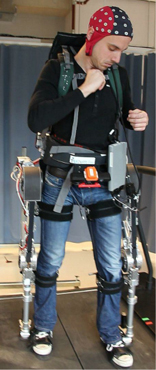On the heels of research which suggests that humans tend to view their prostheses, including wheel chairs, as part of their bodies, researchers in Europe have announced the development of a working exoskeleton powered by the wearer’s thoughts.
First, there’s the ‘wheelchair’ research, from the Mar. 6, 2013 news item on ScienceDaily,
People with spinal cord injuries show strong association of wheelchairs as part of their body, not extension of immobile limbs.
The human brain can learn to treat relevant prosthetics as a substitute for a non-working body part, according to research published March 6 in the open access journal PLOS ONE by Mariella Pazzaglia and colleagues from Sapienza University and IRCCS Fondazione Santa Lucia of Rome in Italy, supported by the International Foundation for Research in Paraplegie.
The researchers found that wheelchair-bound study participants with spinal cord injuries perceived their body’s edges as being plastic and flexible to include the wheelchair, independent of time since their injury or experience with using a wheelchair. Patients with lower spinal cord injuries who retained upper body movement showed a stronger association of the wheelchair with their body than those who had spinal cord impairments in the entire body.
According to the authors, this suggests that rather than being thought of only as an extension of the immobile limbs, the wheelchairs had become tangible, functional substitutes for the affected body part. …
As I mentioned in a Jan. 30, 2013 posting,
There have been some recent legal challenges as to what constitutes one’s body (from The Economist article, You, robot? [you can find the article here: http://www.economist.com/node/21560986]),
If you are dependent on a robotic wheelchair for mobility, for example, does the wheelchair count as part of your body? Linda MacDonald Glenn, an American lawyer and bioethicist, thinks it does. Ms Glenn (who is not involved in the RoboLaw project) persuaded an initially sceptical insurance firm that a “mobility assistance device” damaged by airline staff was more than her client’s personal property, it was an extension of his physical body. The airline settled out of court.
According to the Mar. 6, 2013 news release on EurekAlert from the Public Library of Science (PLoS), the open access article by Pazzaglia and her colleagues can be found here (Note: I have added a link),
Pazzaglia M, Galli G, Scivoletto G, Molinari M (2013) A Functionally Relevant Tool for the Body following Spinal Cord Injury. PLOS ONE 8(3): e58312.doi:10.1371/journal.pone.0058312
At almost the same time as Pazzaglia’s work, a “Mind-controlled Exoskeleton” is announced in a Mar. 7, 2013 news item on ScienceDaily,
Every year thousands of people in Europe are paralysed by a spinal cord injury. Many are young adults, facing the rest of their lives confined to a wheelchair. Although no medical cure currently exists, in the future they could be able to walk again thanks to a mind-controlled robotic exoskeleton being developed by EU-funded researchers.
The system, based on innovative ‘Brain-neural-computer interface’ (BNCI) technology — combined with a light-weight exoskeleton attached to users’ legs and a virtual reality environment for training — could also find applications in there habilitation of stroke victims and in assisting astronauts rebuild muscle mass after prolonged periods in space.
The Mar. 7, 2013 news release on CORDIS, which originated the news item, offers a description of the “Mindwalker” project,
‘Mindwalker was proposed as a very ambitious project intended to investigate promising approaches to exploit brain signals for the purpose of controlling advanced orthosis, and to design and implement a prototype system demonstrating the potential of related technologies,’ explains Michel Ilzkovitz, the project coordinator at Space Applications Services in Belgium.
The team’s approach relies on an advanced BNCI system that converts electroencephalography (EEG) signals from the brain, or electromyography (EMG) signals from shoulder muscles, into electronic commands to control the exoskeleton.
The Laboratory of Neurophysiology and Movement Biomechanics at the Université Libre de Bruxelles (ULB) focused on the exploitation of EEG and EMG signals treated by an artificial neural network, while the Foundation Santa Lucia in Italy developed techniques based on EMG signals modelled by the coupling of neural and biomechanical oscillators.
One approach for controlling the exoskeleton uses so-called ‘steady-state visually evoked potential’, a method that reads flickering visual stimuli produced at different frequencies to induce correlated EEG signals. Detection of these EEG signals is used to trigger commands such as ‘stand’, ‘walk’, ‘faster’ or ‘slower’.
A second approach is based on processing EMG signals generated by the user’s shoulders and exploits the natural arm-leg coordination in human walking: arm-swing patterns can be perceived in this way and converted into control signals commanding the exoskeleton’s legs.
A third approach, ‘ideation’, is also based on EEG-signal processing. It uses the identification and exploitation of EEG Theta cortical signals produced by the natural mental process associated with walking. The approach was investigated by the Mindwalker team but had to be dropped due to the difficulty, and time needed, in turning the results of early experiments into a fully exploitable system.
Regardless of which method is used, the BNCI signals have to be filtered and processed before they can be used to control the exoskeleton. To achieve this, the Mindwalker researchers fed the signals into a ‘Dynamic recurrent neural network'(DRNN), a processing technique capable of learning and exploiting the dynamic character of the BNCI signals.
‘This is appealing for kinematic control and allows a much more natural and fluid way of controlling an exoskeleton,’ Mr Ilzkovitz says.
The team adopted a similarly practical approach for collecting EEG signals from the user’s scalp. Most BNCI systems are either invasive, requiring electrodes to be placed directly into brain tissue, or require users to wear a ‘wet’ capon their head, necessitating lengthy fitting procedures and the use of special gels to reduce the electrical resistance at the interface between the skin and the electrodes. While such systems deliver signals of very good quality and signal-to-noise ratio, they are impractical for everyday use.
The Mindwalker team therefore turned to a ‘dry’ technology developed by Berlin-based eemagine Medical Imaging Solutions: a cap covered in electrodes that the user can fit themselves, and which uses innovative electronic components to amplify and optimise signals before sending them to the neural network.
‘The dry EEG cap can be placed by the subject on their head by themselves in less than a minute, just like a swimming cap,’ Mr Ilzkovitz says.
Before proceeding any further with details, here’s what the Mindwalker looks like,

© MINDWALKER (downloaded from http://cordis.europa.eu/fetch?CALLER=OFFR_TM_EN&ACTION=D&RCN=10601)
After finding a way to collect the EEG/EMG signals and interpret them, the researchers needed to create the exoskeleton (from the CORDIS news release),
The universities of Delft and Twente in the Netherlands proposed an innovative approach for the design of the exoskeleton and its control. The exoskeletonis designed to be sufficiently robust to bear the weight of a 100 kg adult and powerful enough to recover balance from external causes of instability such as the user’s own torso movements during walking or a gentle push from the back or side. Compared to other exoskeletons developed to date it is relatively light, weighing less than 30 kg without batteries, and, because a final version of the system should be self-powered, it is designed to minimise energy consumption.
The Mindwalker researchers achieved energy efficiency through the use of springs fitted inside the joints that are capable of absorbing and recovering some of the energy otherwise dissipated during walking, and through the development of an efficient strategy for controlling the exoskeleton.
Most exoskeletons are designed to be balanced when stationary or quasi-static and to move by little steps inside their ground stability perimeter, an approach known as ‘Zero moment point’, or ZMP. Although this approach is commonly used for controlling humanoid robots, when applied to exoskeletons, it makes them heavy and slow – and usually requires users to be assisted by a walking frame, sticks or some other support device when they move.
Alternatively, a more advanced and more natural control strategy can replicate the way humans actually walk, with a controlled loss of balance in the walking direction.
‘This approach is called “Limit-cycle walking” and has been implemented using model predictive control to predict the behaviour of the user and exoskeleton and for controlling the exoskeleton during the walk. This was the approach investigated in Mindwalker,’ Mr Ilzkovitz says.
To train users to control the exoskeleton, researchers from Space Applications Services developed a virtual-reality training platform, providing an immersive environment in which new users can safely become accustomed to using the system before testing it out in a clinical setting, and, the team hope, eventually using it in everyday life.
By the end of this year, tests with able-bodied trial users will be completed. The system will then be transferred to the Foundation Santa Lucia for conducting a clinical evaluation until May 2013 with five to 10volunteers suffering from spinal cord injuries. These trials will help identify shortcomings and any areas of performance improvement, the project coordinator says.
In the meantime, the project partners are continuing research on different components for a variety of potential applications. The project coordinator notes, for example, that elements of the system could be adapted for the rehabilitation of stroke victims or to develop easy-to-use exoskeletons for elderly people for mobility support.
Space Applications Services, meanwhile, is also exploring applications of the Mindwalker technology to train astronauts and help them rebuild muscle mass after spending long periods of time in zero-gravity environments.
There’s more about the European Commission’s Seventh Programme-funded Mindwalker project here.
Parallel with these developments in Europe, Miguel Nicolelis of Duke University has stated that he will have a working exoskeleton (Walk Again Project) for the kickoff by a paraplegic individual for the opening of the World Cup (soccer/football) in Brazil in 2014. I mentioned Nicolelis and his work most recently in a Mar. 4, 2013 posting.
Taken together, this research which strongly suggests that people can perceive prostheses as being part of their bodies and exoskeletons that are powered by the wearer’s thoughts, we seem to be edging closer to a world where machines and humans become one.



